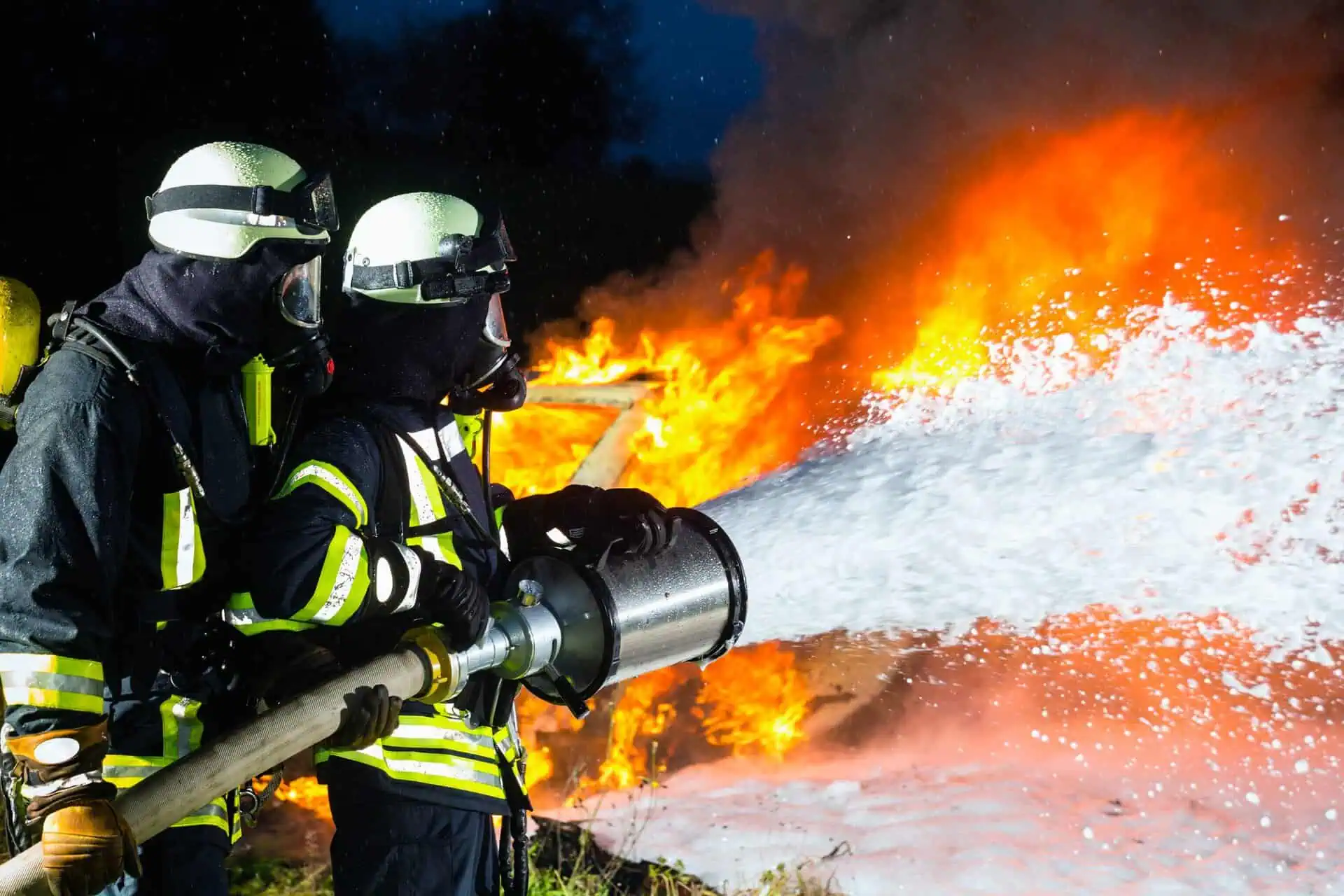AFFF Mesothelioma Lawsuit
- Last Updated: June 12th, 2025

Attorney Jessica Paluch-Hoerman, founder of TruLaw, has over 28 years of experience as a personal injury and mass tort attorney, and previously worked as an international tax attorney at Deloitte. Jessie collaborates with attorneys nationwide — enabling her to share reliable, up-to-date legal information with our readers.
Legally Reviewed
This article has been written and reviewed for legal accuracy and clarity by the team of writers and legal experts at TruLaw and is as accurate as possible. This content should not be taken as legal advice from an attorney. If you would like to learn more about our owner and experienced injury lawyer, Jessie Paluch, you can do so here.
Fact-Checked
TruLaw does everything possible to make sure the information in this article is up to date and accurate. If you need specific legal advice about your case, contact us by using the chat on the bottom of this page. This article should not be taken as advice from an attorney.
Key takeaways:
- AFFF, a toxic firefighting foam containing PFAS chemicals, may cause mesothelioma, leading to legal actions by those affected.
- Victims with mesothelioma from AFFF exposure are filing lawsuits for justice and compensation with the help of specialized lawyers.
- Evidence linking AFFF exposure to cancer includes medical records, occupational history, and scientific studies on PFAS health impacts from dangerous chemicals.
AFFF Mesothelioma Lawsuit Overview
On this page, we will provide an overview of the AFFF Mesothelioma Lawsuit, potential AFFF lawsuit settlement amounts, eligibility criteria for filing an AFFF lawsuit, and much more.
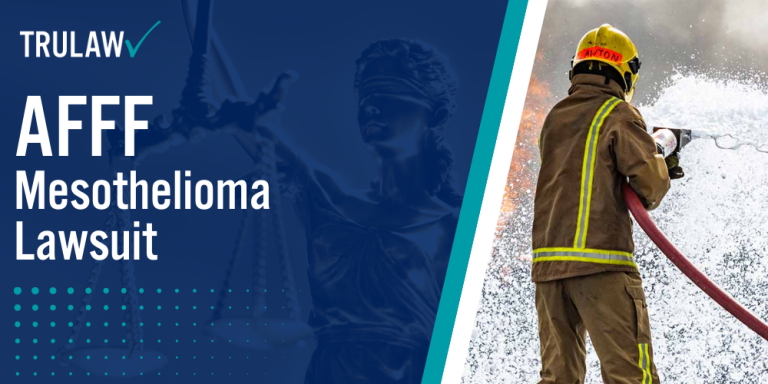
Intro to the AFFF Mesothelioma Lawsuits
Aqueous Film Forming Foam (AFFF) has been used in various industries since the 1960s to extinguish fires fueled by liquids or gases.
Numerous firefighting foams contain PFAS, commonly known as “forever chemicals,” which have been associated with various cancers, such as mesothelioma, as well as other serious health risks.
AFFF foam lawsuits are being filed by individuals across the country who believe their exposure to AFFF has contributed to their health problems.
If you or a loved one were exposed to AFFF and have developed cancer, such as mesothelioma, or other related health conditions, you may be eligible to pursue legal action.
The experienced firefighting foam lawyers at TruLaw and our partner law firms are here to help individuals explore their legal options.
Our team is available to answer any questions you may have about your potential claim.
If you believe you may have been affected by AFFF exposure, don’t hesitate to reach out and learn more about how we can help.
Table of Contents
Links Between AFFF Exposure and Mesothelioma
Exposure to firefighting foam and PFAS chemicals has been linked to an increased risk of developing cancer, including mesothelioma.
These connections have been highlighted in several major research studies conducted by reputable agencies such as the National Cancer Institute and the Environmental Protection Agency.
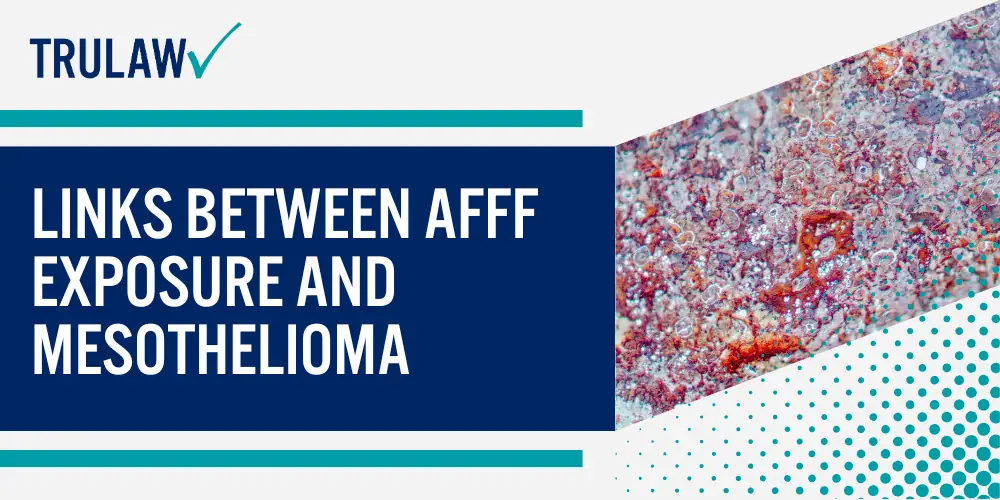
Some studies have identified a potential link between PFAS-containing firefighting foam and mesothelioma:
- A study in Environmental Health found a connection between PFAS exposure and an increased risk of mesothelioma.
- Researchers from Emory University and the CDC reviewed PFAS exposure and its connection to various cancers, including mesothelioma.
Mesothelioma is a rare but aggressive form of cancer affecting the mesothelium, the thin layer of tissue surrounding most internal organs.
While treatments are available, a cure may not be possible for many individuals diagnosed with this disease.
Ongoing Research on PFAS Chemicals and Cancer Risks
Extensive research continues to highlight the potential risks associated with PFAS chemicals, including a connection to various cancers:
- The U.S. Environmental Protection Agency (EPA) has issued a health advisory for PFOA and PFOS, warning that long-term exposure to these chemicals could be harmful to human health.
- The International Agency for Research on Cancer (IARC) classified PFOA and PFOS as possible carcinogens, indicating a concerning link between these chemicals and human health risks.
- A study in the Journal of the American Medical Association identified a link between PFOA exposure and increased risks for kidney cancer, testicular cancer, and other conditions.
- A study published in the International Journal of Cancer identified a positive link between PFOS exposure and the development of breast cancer.
As research continues, the evidence linking PFAS exposure to cancer grows, prompting further investigation into the adverse health outcomes of these chemicals.
AFFF Firefighting Foam Cancer Lawsuits
Manufacturers of firefighting foam products containing PFAS are facing lawsuits for the role these chemicals play in causing cancer and other health issues.
The Centers for Disease Control and Prevention (CDC) and the Environmental Protection Agency (EPA) have issued warnings about the dangers linked to exposure to these chemicals.
PFAS remain in the environment and the human body, presenting long-term health risks.
Exposure to PFAS has been associated with several cancers, including bladder, prostate, testicular, and kidney cancer, among others.
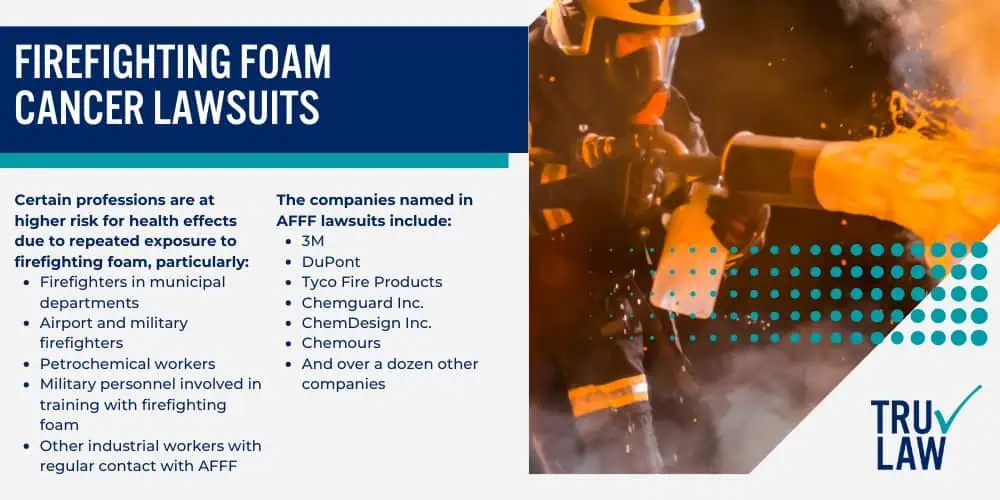
Certain professions may face higher exposure risks due to the regular use of firefighting foam, including:
- Petrochemical workers
- Firefighters at municipal fire departments
- Military personnel involved in training exercises with firefighting foam
- Airport and military firefighters
- Other industrial workers
The companies facing AFFF lawsuits include:
- Tyco Fire Products
- 3M
- Chemours
- DuPont
- Dynax Corp.
- UTC Fire & Security Americas
- Several other manufacturers
Settlement Amounts in AFFF Firefighting Foam Lawsuits
At this stage, it is too early to determine an exact range for AFFF lawsuit settlement amounts.
Based on outcomes from previous PFAS contamination cases, attorneys anticipate that average AFFF lawsuit settlement amounts might fall between $20,000 and $600,000 or more.
These estimates are not guaranteed, and compensation will depend on the specifics of each individual case.
As litigation progresses, more information will become available, and we will have a clearer understanding of potential settlement outcomes.
Toxic Firefighting Foam Contamination in Groundwater and Drinking Water
AFFF firefighting foam has been a large source of PFAS contamination in groundwater and drinking water.
Because PFAS chemicals are highly soluble, they can spread rapidly and persist in the environment, leading to widespread contamination.
While environmental lawsuits related to AFFF contamination have been filed by various state and city governments, we primarily focus on assisting individuals affected by AFFF exposure.
The continued investigation into these toxic chemicals’ impact on public health highlights the urgency of addressing this issue.
It’s important to note that TruLaw is only accepting clients with AFFF personal injury claims — we are not accepting clients for the AFFF municipal water contamination lawsuits.
How to File an AFFF Firefighting Foam Lawsuit
If you or a loved one has been exposed to PFAS chemicals through AFFF firefighting foam and were subsequently diagnosed with mesothelioma, another type of cancer, or related health conditions, you may be qualify for legal action.
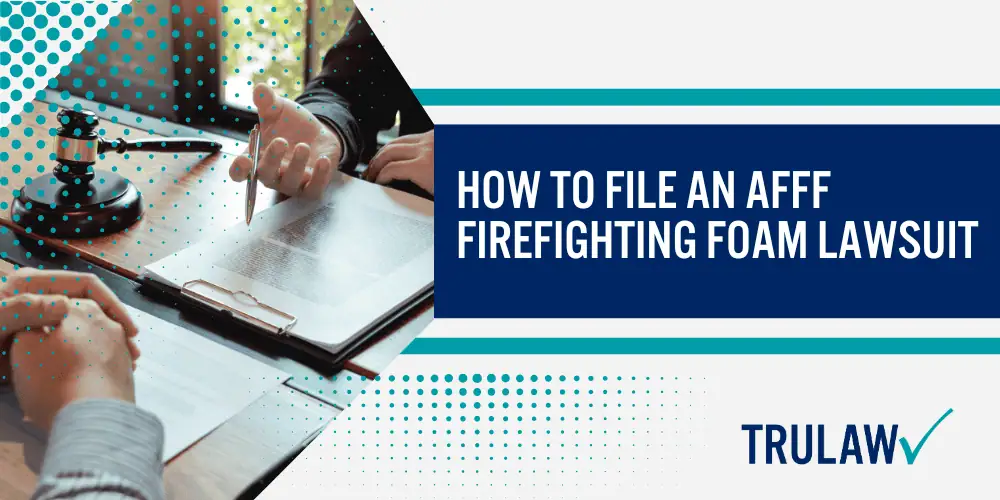
In that case, you may be eligible to seek compensation through an AFFF foam cancer lawsuit.
Contact us for a free consultation by using the chatbot on this page to instantly determine if you qualify for an AFFF lawsuit.
Collecting Evidence for AFFF Lawsuits
The success of an AFFF firefighting foam lawsuit often depends on the quality of evidence.
The firefighting foam attorneys at TruLaw and our partner law firms will help you identify and gather the necessary documentation to support your firefighting foam claim.
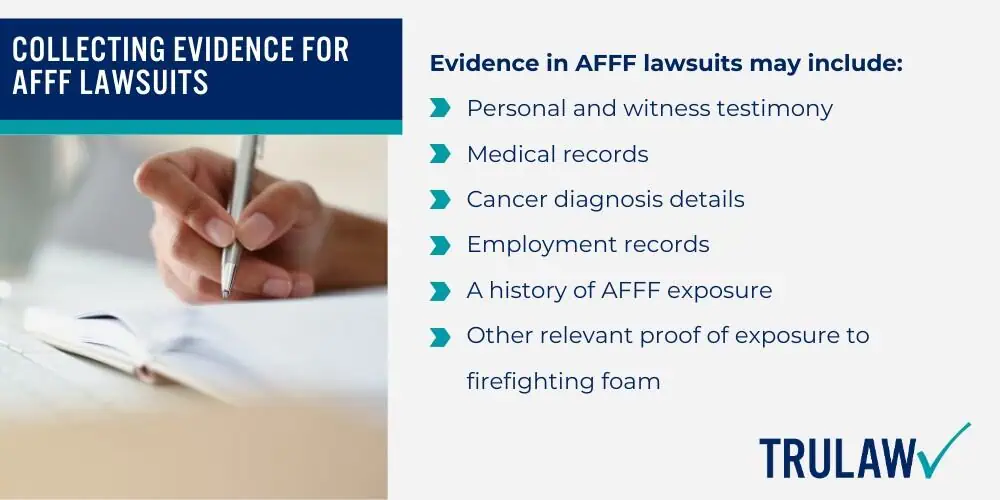
Evidence for AFFF lawsuits may include:
- Medical records
- Cancer diagnosis information
- Employment history
- Proof of AFFF exposure
- Personal and witness testimony
- Any additional documentation verifying exposure to firefighting foam
Compensation for Damages in AFFF Firefighting Foam Lawsuits
Assessing damages is an important part of the lawsuit process.
We will assist in evaluating both economic and non-economic losses you have suffered due to AFFF exposure.
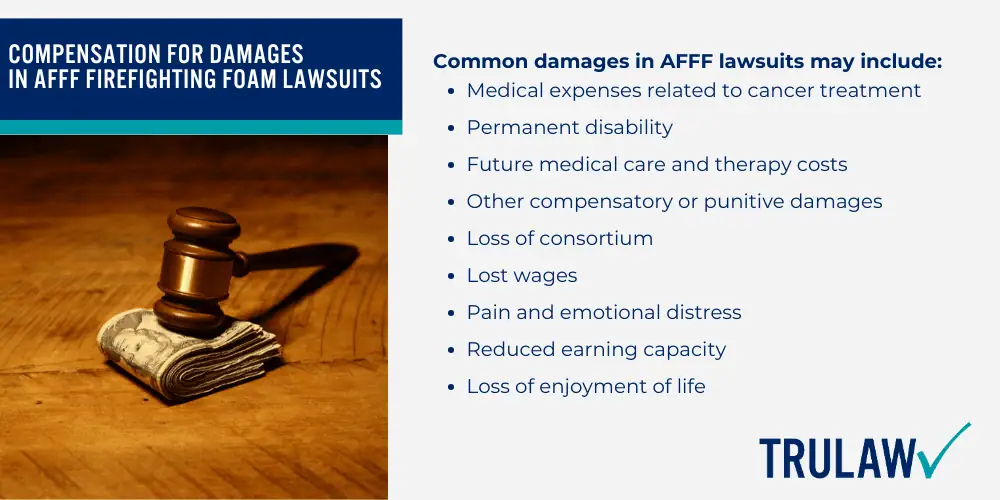
Common damages in AFFF lawsuits may include:
- Medical expenses related to cancer treatment
- Permanent disability
- Future medical care and therapy costs
- Other compensatory or punitive damages
- Loss of consortium
- Lost wages
- Pain and emotional distress
- Reduced earning capacity
- Loss of enjoyment of life
The Importance of Hiring Experienced Attorneys for Your Firefighting Foam Claim
Hiring attorneys who have experience in handling toxic exposure claims can have an impact the outcome of your case.
These legal professionals will guide you through the civil litigation process and work diligently to strengthen your claim.
At TruLaw, we understand the profound impact an AFFF-related cancer diagnosis can have on an individual’s life.
The AFFF lawyers at TruLaw and our partner law firms strive to ensure that those affected receive the attention and resources they need — we are committed to supporting our clients at every step.
Use the chat on this page for an instant case evaluation to quickly determine if you qualify to file an AFFF lawsuit.
TruLaw: Your Firefighting Foam Cancer Law Firm
The experienced firefighting foam lawyers at TruLaw and our partner law firms are dedicated to holding large corporations and firefighting foam manufacturers accountable for the harm caused by AFFF exposure.
If you or a loved one has developed cancer or other serious health problems after regular exposure to firefighting foam, you may be eligible to file an AFFF lawsuit.
Contact us today for a free consultation by using the chat on this page to instantly see if you qualify to file an AFFF lawsuit.
AFFF Lawsuit Frequently Asked Questions
-
Per- and Polyfluoroalkyl Substances (PFAS) are synthetic chemicals commonly utilized across different industries because of their ability to resist heat, water, oil, and stains.
These chemicals have been used in products like firefighting foam, non-stick cookware, and water-repellent clothing.
Unfortunately, PFAS are toxic and persist in the environment, leading to their gradual accumulation in the human body over time.
This buildup has been linked to potential health risks such as cancer, birth defects, and other serious health issues.
As awareness grows, PFAS chemicals are being banned in several states and countries.
-
Aqueous Film Forming Foam (AFFF) is a firefighting foam used to extinguish dangerous fires, particularly those involving jet fuel, petroleum, and other flammable liquids.
It works by creating a film that blocks oxygen from the fire, suppressing it effectively.
Since the 1960s, AFFF has been used in industries such as aviation, military, and petrochemical, with manufacturers like 3M, Chemguard, and Tyco Fire Products producing the foam.
While it has been useful in fire suppression, its association with PFAS chemicals has raised severe health and environmental concerns.
-
In addition to firefighting foam, PFAS chemicals are found in a variety of consumer products, including:
- Plastic wrappers and microwave popcorn bags
- Plastic bottles
- Cleaning products
- Grease-resistant paper
- Nonstick cookware
- Personal care items (e.g., shampoo, dental floss, nail polish, and eye makeup)
- Stain-resistant coatings for carpets, upholstery, and other fabrics
- Water-resistant fabrics (e.g., rain jackets, umbrellas, and tents)
These widespread uses have contributed to the ongoing concern regarding PFAS exposure.
-
Those most at risk of exposure to PFAS in firefighting foam are individuals who have worked with or transported the foam, or who may have been exposed through contaminated drinking water.
The following groups are more likely to experience occupational exposure to firefighting foam:
- Airport and military firefighters
- Municipal firefighters
- Industrial workers at refineries and similar facilities
- Individuals working on flight decks
- Employees of AFFF manufacturers
- Those who transported AFFF firefighting foam
- Incinerator workers disposing of firefighting foam
These individuals are at a heightened risk of developing health problems associated with PFAS exposure.
-
Exposure to PFAS chemicals has been linked to several cancers and other serious health conditions, including:
- Thyroid cancer
- Thyroid disease
- Ulcerative colitis
- Non-Hodgkin’s lymphoma
- Lymphoma
- Ovarian cancer
- Endometrial cancer
- Mesothelioma
- Pancreatic cancer
- Testicular cancer
- Kidney cancer
- Bladder cancer
- Prostate cancer
- Breast cancer
- Colorectal cancer
- Leukemia
- Liver cancer
- Neuroendocrine tumors
- Hormonal imbalances
- Birth defects
- Heart disease
- Other health problems
-
The AFFF lawsuits target the manufacturers and suppliers of firefighting foam used by military bases, airports, fire departments, and various other industries.
These companies include:
- Chemours
- Tyco Fire Products
- Chemguard Inc
- 3M
- DuPont
- ChemDesign Inc
- Numerous other manufacturers
These companies are facing lawsuits due to the harmful effects of the PFAS chemicals found in their firefighting foam products.
-
The AFFF MDL (multidistrict litigation) has been established in the US District Court for the District of South Carolina.
MDL is a federal legal process used to consolidate multiple lawsuits involving similar claims to streamline pretrial procedures.
The AFFF MDL groups together lawsuits filed by individuals exposed to firefighting foam, helping the court system manage these cases more efficiently.
This process is particularly useful when a large number of people are affected by the same product or issue.
-
Attorneys experienced in firefighting foam cases can assist you through the legal process in several important ways, including:
- Gathering evidence to support your AFFF lawsuit
- Evaluating your damages and the financial impact of exposure to firefighting foam
- Identifying who is responsible for your exposure and cancer diagnosis
- Providing guidance and answering any questions throughout the legal process
- Working to secure a settlement for your AFFF cancer lawsuit
These steps are important to build a strong case and pursuing compensation for the damages you’ve suffered due to AFFF exposure.
-
The firefighting foam attorneys at TruLaw and our partner law firms operate on a contingency fee basis.
This means there are no upfront costs for legal representation.
Instead, legal fees are only collected if your case reaches a successful settlement or verdict.
If no settlement or compensation is awarded for your AFFF lawsuit, you won’t owe any legal fees, allowing you to pursue your claim without financial risk on your end.
It’s important to note that TruLaw is only accepting clients with AFFF personal injury claims — we are not accepting clients for the AFFF municipal water contamination lawsuits.

Managing Attorney & Owner
With over 25 years of legal experience, Jessica Paluch-Hoerman is an Illinois lawyer, a CPA, and a mother of three. She spent the first decade of her career working as an international tax attorney at Deloitte.
In 2009, Jessie co-founded her own law firm with her husband – which has scaled to over 30 employees since its conception.
In 2016, Jessie founded TruLaw, which allows her to collaborate with attorneys and legal experts across the United States on a daily basis. This hypervaluable network of experts is what enables her to share the most reliable, accurate, and up-to-date legal information with our readers!
Additional AFFF Lawsuit resources on our website:
Here, at TruLaw, we’re committed to helping victims get the justice they deserve.
Alongside our partner law firms, we have successfully collected over $3 Billion in verdicts and settlements on behalf of injured individuals.
Would you like our help?
At TruLaw, we fiercely combat corporations that endanger individuals’ well-being. If you’ve suffered injuries and believe these well-funded entities should be held accountable, we’re here for you.
With TruLaw, you gain access to successful and seasoned lawyers who maximize your chances of success. Our lawyers invest in you—they do not receive a dime until your lawsuit reaches a successful resolution!
AFFF Lawsuit claims are being filed against manufacturers of aqueous film-forming foam (AFFF), commonly used in firefighting.
Claims allege that companies such as 3M, DuPont, and Tyco Fire Products failed to adequately warn users about the potential dangers of AFFF exposure — including increased risks of various cancers and diseases.
Depo Provera Lawsuit claims are being filed by individuals who allege they developed meningioma (a type of brain tumor) after receiving Depo-Provera birth control injections.
A 2024 study found that women using Depo-Provera for at least 1 year are five times more likely to develop meningioma brain tumors compared to those not using the drug.
Suboxone Tooth Decay Lawsuit claims are being filed against Indivior, the manufacturer of Suboxone, a medication used to treat opioid addiction.
Claims allege that Indivior failed to adequately warn users about the potential dangers of severe tooth decay and dental injuries associated with Suboxone’s sublingual film version.
Social Media Harm Lawsuits are being filed against social media companies for allegedly causing mental health issues in children and teens.
Claims allege that companies like Meta, Google, ByteDance, and Snap designed addictive platforms that led to anxiety, depression, and other mental health issues without adequately warning users or parents.
Transvaginal Mesh Lawsuits are being filed against manufacturers of transvaginal mesh products used to treat pelvic organ prolapse (POP) and stress urinary incontinence (SUI).
Claims allege that companies like Ethicon, C.R. Bard, and Boston Scientific failed to adequately warn about potential dangers — including erosion, pain, and infection.
Bair Hugger Warming Blanket Lawsuits involve claims against 3M — alleging their surgical warming blankets caused severe infections and complications (particularly in hip and knee replacement surgeries).
Plaintiffs claim 3M failed to warn about potential risks — despite knowing about increased risk of deep joint infections since 2011.
Baby Formula NEC Lawsuit claims are being filed against manufacturers of cow’s milk-based baby formula products.
Claims allege that companies like Abbott Laboratories (Similac) and Mead Johnson & Company (Enfamil) failed to warn about the increased risk of necrotizing enterocolitis (NEC) in premature infants.
Here, at TruLaw, we’re committed to helping victims get the justice they deserve.
Alongside our partner law firms, we have successfully collected over $3 Billion in verdicts and settlements on behalf of injured individuals.
Would you like our help?
